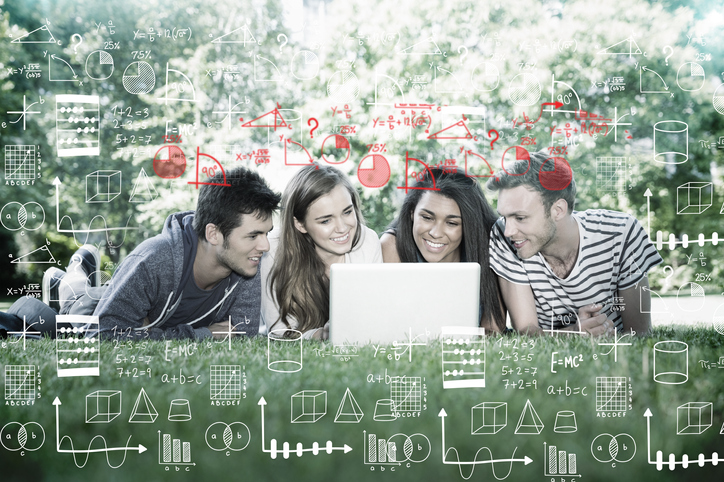Students are often unmotivated toward abstract science learning. However, this is different from the needs of our global reality. In the knowledge society, the mastery of science, technology, and mathematics is fundamental for all citizens because these skills are increasingly demanded in the labor market. In the Webinar of the Observatory of the Institute for the Future of Education at Tecnologico de Monterrey, Drs. Maritza Peña and Claudia Camacho shared with us a didactic-sequence structure for teaching and learning mathematics and physics that, at the university level, has been shown to increase students’ motivation by developing their sense of usefulness. This article summarizes the webinar session.
“From the mathematics and physics classrooms, it is possible to form full, informed, free, responsible citizens and members of the knowledge society.”
Science has proven to be an indispensable tool in solving problems that threaten us as a species. We recently experienced that in the pandemic due to the COVID-19 virus. To understand the world around us, we must have mathematical and physical skills, and we also need to develop ethical skills and responsible citizenship in students for their integral development. Thus explained the proponents, Drs. Peña and Camacho in this session of the Observatory.
Finding a sense of math usefulness is key
We must create appropriate contexts to foster students’ motivation to study and learn mathematics. It is crucial to consider students’ interests to show them the usefulness of mathematics through real and everyday problems. In the webinar, the doctors discuss cases for understanding mathematics; for example, how can we determine the price of a life? What data do we need, and what tools can we use?, Why should we use a helmet and appropriate clothing to ride a bicycle? Why can a pen stop us before the arrival of a train? How long does it take for alcohol to concentrate in the blood? These were several contexts mentioned in the session by our exponents that you can know in their book “Mathematical Thinking 1,” thought out and designed for social sciences students with exercises designed to apply mathematics to real and everyday problems.
Dr. Marisa commented that to develop students’ sense of the usefulness of mathematics, we must first know and appreciate their interests. To achieve this, we can ask them if the power to solve a real problem were in their hands, what or which would they be? What problem would you like to solve? Their answers should be the topics that the class addresses. For example, they might say, “corruption, poverty, hunger, river cleanliness, environmental conditions, etc.” Eliciting their interests generates their sense of belonging, and they can find the usefulness of mathematics and physics. It would be only the first step. Later we would have to construct the data, relating it to the problems to which the students are exposed in the disciplinary and study program topics, and finally, close with a reflection of the initial problem. In this way, students realize that mathematics is a tool to solve problems that affect them.
“Mathematics is also a language that allows communicating ideas. If we cannot communicate our ideas, we will never be able to materialize them.”
STEM disciplinary competencies and ethical and civic competencies
Below is Drs. Peña’s and Camacho’s proposal. A didactic sequence to develop STEM disciplinary and ethical, and civic competencies were discussed in the webinar.
- Generate a sense of belonging to a problem. Start the activity with a problem that impacts students directly to sow in them a sense of belonging.
- Analyze the construction of the data. Identify where to get the necessary data, what other information would be needed, what formulas the students will need to use, and why.
- Relate the previous two points to disciplinary analysis. Take the previous two steps into the classroom curriculum, for example, in learning the equation of a line, Laplace transformations, and multiplication and division, to name a few.
- Encourage reflection on the part of students and the teacher. An activity should not end with a numerical solution or equation. On the contrary, it should close with a reflection on the initial problems to reinforce the students’ sense of belonging. The reflection allows economic, political, or environmental phenomena to become the protagonists of the entire scenario while students apply mathematics, strengthening their sense of belonging.
We must strengthen transversal competencies in graduates of all disciplines. Transversal competencies are not specific to an area or discipline; they are characteristics we must develop in students from all areas of teaching, as expressed by Professors Maritza and Claudia in this session.
They also propose synergy with other teachers who wish to test the designs of their activities under the perspective explained in this article and the webinar. If you want to share your experiences with the professors, they can support you, so your innovation is validated, tested, presented at a congress, and published. In such a way, teachers validate their innovations and share them with the academic community. If you are interested, leave us your information in the comments section of this article.
Relive this webinar. If your native language is not Spanish, you can turn on the YouTube subtitled instant translation included in this article. To activate this option, select the Subtitles option on YouTube (Spanish subtitles will appear), then select the Settings ->Subtitles -> Automatically Translate option and the language you prefer.
Dr. Maritza Peña Becerril (maritza@tec.mx) is a research professor in mathematics and its teaching. She has more than 25 years of teaching experience, is a lecturer and teacher, and seeks to contribute to her students’ professional and personal development by teaching exact sciences. Currently works at the School of Engineering and Sciences at the Tecnologico de Monterrey Campus in Toluca. She is the leader of the regional project “Mathematical Debates: Social Discussions from Mathematics,” a project that seeks to strengthen the sense of mathematics’ usefulness among Social Sciences students.
Dr. Claudia Camacho Zuñiga (claudia.camacho@tec.mx) is a professor of sciences oriented to research, innovation, and transformation of higher education. She has more than 25 years of experience. Currently, she is a researcher at the Institute for the Future of Education and a professor at the School of Engineering and Sciences at the Tecnologico de Monterrey campus in Toluca. Since 2014, she has been developing innovation and educational research to foster in university students a passion for science, ethical and citizen commitment, and an appreciation for the diversity of knowledge and people.
Translation by Daniel Wetta
This article from Observatory of the Institute for the Future of Education may be shared under the terms of the license CC BY-NC-SA 4.0 
)
)


)